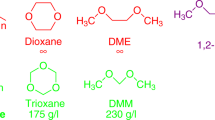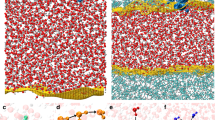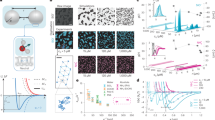Abstract
HYDROPHOBIC interactions are important in maintaining the conformations of proteins and various macromolecules. The free energies of these interactions are entropic in origin, for the enthalpy changes are actually unfavourable at low temperatures (ΔH>0). It is generally believed that around the nonpolar parts of the solutes in contact with water there is an increased ordering1–3 of the water molecules as a result of hydrogen bonding, and that on the formation of the hydrophobic bond this order is diminished so that there is a positive entropy change. We have recently shown4 that there are solvophobic interactions in ethylene glycol, a polar nonaqueous solvent, chiefly on the grounds of the formation of micelles by several cationic detergents and the limited solubility of hydrocarbons in this solvent.
This is a preview of subscription content, access via your institution
Access options
Subscribe to this journal
Receive 51 print issues and online access
$199.00 per year
only $3.90 per issue
Buy this article
- Purchase on Springer Link
- Instant access to full article PDF
Prices may be subject to local taxes which are calculated during checkout
Similar content being viewed by others
References
Frank, H. S., and Evans, M. W., J. Chem. Phys., 13, 507 (1945).
Kauzmann, W., Adv. Protein Chem., 14, 1 (1959).
Némethy, G., and Scheraga, H., J. Chem. Phys., 36, 3401 (1962).
Ray, A., J. Amer. Chem. Soc., 91, 6511 (1969).
Adam, N. K., The Physics and Chemistry of Surfaces, 383 (Dover, New York, 1968).
Kitahara, A., Kobayashi, T., and Tachibana, T., J. Phys. Chem., 66, 363 (1962).
Little, R. C., and Singleterry, C. R., J. Phys. Chem., 68, 2709 (1964).
The Handbook of Chemistry and Physics, fiftieth ed. (The Chemical Rubber Co., 1969).
Heilweil, I. J., J. Colloid Sci., 19, 105 (1964).
Fryar, A. J., and Kaufman, S., J. Colloid and Interface Sci., 29, 444 (1969).
Hildebrand, J. H., and Scott, R. L., The Solubility of Non-electrolytes, third ed. (Dover, New York, 1964).
DeSando, R. J., and Brown, G. H., J. Phys. Chem., 72, 1088 (1968).
Ladell, J., and Post, B., Acta Cryst., 7, 559 (1954).
Leader, G. R., and Gormley, J. F., J. Amer. Chem. Soc., 73, 5731 (1951).
Franks, F., and Ives, D. J. G., Quart. Rev., 20, 1 (1966).
Mukerjee, P., and Ray, A., J. Phys. Chem., 67, 190 (1963).
Abu-Hamdiyyah, M., J. Phys. Chem., 69, 2720 (1965).
McDonald, C., J. Pharm. Pharmacol., 22, 10, 774 (1970).
Author information
Authors and Affiliations
Rights and permissions
About this article
Cite this article
RAY, A. Solvophobic Interactions and Micelle Formation in Structure Forming Nonaqueous Solvents. Nature 231, 313–315 (1971). https://doi.org/10.1038/231313a0
Received:
Revised:
Issue Date:
DOI: https://doi.org/10.1038/231313a0
This article is cited by
-
Probing the nanofriction of non-halogenated phosphonium-based ionic liquid additives in glycol ether oil on titanium surface
Friction (2022)
-
CLIP: Carbon Dioxide testing suitable for Low power microelectronics and IOT interfaces using Room temperature Ionic Liquid Platform
Scientific Reports (2020)
-
Dynamically arrested micelles in a supercooled sugar urea melt
Communications Chemistry (2018)
-
Rheological Properties and Microstructure Transition in Mixture of Zwitterionic Surfactant, Anionic Surfactant and Salts in Sorbitol/H2O Solvent: 2. Effect of Salts and Sorbitol
Journal of Surfactants and Detergents (2017)
-
Refractive index in relation to solvent effects on the amphiphilic association of n-alkylammonium carboxylates
Colloid and Polymer Science (2016)
Comments
By submitting a comment you agree to abide by our Terms and Community Guidelines. If you find something abusive or that does not comply with our terms or guidelines please flag it as inappropriate.



